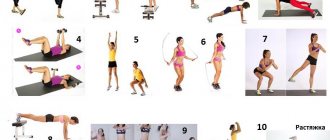The ability to create an individual training plan distinguishes beginners from professionals. To achieve maximum results, it is important to understand how to correctly change the program “to suit you”, as well as how to distribute training of different muscle groups over the days.
In addition, a personal training program involves adherence to a regimen and recording of results. It's impossible to progress in training without carefully analyzing how well (or poorly) specific exercises are working - and whether the workload is increasing.
Making a program: step-by-step tips
The basic rules for drawing up a training plan are for the head to determine the goal of the training (gaining weight, drawing relief or losing weight) - and analyzing the available equipment. It is also necessary to consider the frequency of training:
Create a basic lesson plan
At the beginning of the workout there is always a warm-up (5-10 minutes), then 3-4 exercises for one of the major muscle groups (legs, back, chest), followed by 4-5 exercises for secondary muscles (most often the shoulders are combined with the legs, biceps with the back, and triceps with the chest) and a cool-down (5-10 minutes). If you want to lose weight, then 20-25 minutes after training are devoted to cardio.
// Warm-up before strength training - exercises
Determine your top training priorities
It is permissible to train lagging muscle groups twice a week - however, with a 2-3 day break for rest (for example, on Monday and Friday). In addition, to target the abdominal muscles, the warm-up may include 3-4 sets of abdominal exercises, and the cool-down may include hanging leg raises or another “big” exercise for the core muscles.
// Basic abdominal exercises - with names
Choose the exercises that suit you
In the first block of exercises (working large muscle groups), it is recommended to include basic exercises or their variations in simulators. A block of exercises for secondary muscles should include various isolation exercises, varying them to assess effectiveness.
// Basic exercises with a barbell
Plan the number of sets and repetitions
For muscle growth, the total number of approaches for each large muscle group is recommended in the range of 12-15 - that is, 3 exercises of 4 sets or 4 exercises of 3-4 approaches. The first block of exercises uses a larger working weight and fewer repetitions (from 5 to 10), while the second block uses a lighter working weight and an increased number of repetitions (from 10 to 15).
// How muscles grow - in simple words
Follow the progress
Most athletes spend at least 4-5 hours a week (including travel) on strength training. By being too lazy to spend an extra 20 minutes a week to record and then analyze your training program and possible improvements, you significantly reduce the benefit of the time “spent” on training.
// Training diary - how to create it
How many times a week should you lift weights?
Most people train with weights using some sort of body part separation program. Chest on Monday, back on Tuesday, legs on Wednesday, etc. There is nothing glaringly wrong with this approach, and it has always been the preferred schedule among bodybuilders.
However, for most bodybuilders of average genetics who do not use drugs, there is no clear advantage of this program over a full body workout. Most studies have shown that the total amount of work you do to a muscle during a training week matters more than how you perform it.
A 2016 study published in the International Journal of Exercise Science compared subjects doing separate workouts for each body part (chest, shoulders and triceps one day, back and biceps the next, then legs) with a group that preferred training the entire body. bodies.
The zone-specific guys did nine sets of each muscle group once a week, while the "total body" team trained each zone three times a week for three sets each—so the total training volume was the same. After eight weeks, muscle and strength gains were about the same in the two groups. This means you don't have to break a muscle with long, grueling workouts to make it grow.
It's a matter of efficiency. If doing three sets three times a week produces the same results as bombarding a body part once a week, wouldn't it make sense to use the minimum effective dose? If you train your entire body every workout, you don't need to do multiple workouts to cover all zones at least once a week.
A full body workout is especially beneficial if you have a busy schedule that causes you to skip workouts from time to time. If you zone your workouts and skip a day, you could end up going a week or more without training a muscle group, and this could cost you your progress.
Whereas, for example, if you train your chest a little on Monday, Wednesday and Friday, skipping a day only costs you a few percent of your total volume for the week. And what? You just hit your chest two days earlier and you already know you're going to hit your chest again next workout.
Full body training also allows you to train harder. On leg day, after you've completed your squats, you may have some strength left to do Romanian deadlifts or intense lunges. But in a full-body workout, you're relatively fresh in each exercise.
Heavy squats won't impact your bench too much, so you can give each muscle group a proper boost to growth. While you may be able to lift more weight, you won't experience as much soreness in a full-body workout as you would if you only focused on one body part or muscle area for the entire workout. The next day after a full-body workout, you won't be too tired or have tense muscles.
You will be able to train the same muscles at least twice a week. For example, you could build your first upper body day using bench presses and deadlifts, squats on your lower body day, do shoulder work and pull-ups on your second upper body workout, and then do deadlifts on your second leg day. . However, there are several aspects of full-body training three or more days a week that can make it an even smarter choice.
Mass gain program
The basic program is considered to be the most effective for gaining muscle mass - especially for naturally thin guys. Its logic is based on the fact that muscle growth works best with five multi-joint basic exercises, performed in 4-6 sets of 4-6 repetitions (this, in turn, requires large working weights) and increasing the load in each workout.
When drawing up an individual training plan for muscle growth, it is recommended to take the basic program as a basis, modifying it to suit your own needs, your work or study schedule, as well as the equipment available. However, it is important to remember that the purpose of your training and your age will always impose restrictions on the specifics of the training.
Training muscle groups by day
In most cases, the preparation of a program with a breakdown of muscle groups by day is based on a combination of strength training with other physical activities that a person practices. For example, if you go swimming on Tuesday, then it is best to train your back and arms on Friday rather than on Monday.
In any case, as we already mentioned above in the rules for creating a program, first the main muscle group of the day is selected (legs, back, chest), then secondary ones are added to the exercises for this muscle group (most often shoulders are combined with legs, biceps with back, and triceps with chest) - however, this is a general recommendation, and an individual training plan may be drawn up differently.
Why is it necessary to correctly combine muscle groups?
A person has about 620 muscles. To avoid confusion and simplify the terminology, all these muscles were combined into 8 main muscle groups.
These are muscle groups such as the muscles of the neck, chest, shoulders, arms, back, abdomen, buttocks and legs.
In turn, these main muscle groups are divided into subgroups.
For example, the arm muscles are divided into biceps, triceps and forearm. And the legs - on the quadriceps, hamstrings and calves.
But this is only one of the possible classifications. In bodybuilding, there are several of them.
The next classification is when muscle groups are conventionally divided into pulling and pushing. This classification is controversial in the scientific world, but in the world of bodybuilding it has taken root.
For example, pulling muscle groups include the lats, biceps and hamstrings. And the pushing muscles are the chest, shoulder, triceps and quadriceps muscles.
Moreover, some muscle groups (neck, lower leg, abdomen, buttocks) may belong to both groups.
Now let’s figure out why it is necessary to correctly combine muscle groups.
The first reason is optimization of the training process. You will be able to make greater gains in muscle mass and strength in less time.
The second reason (more important) is recovery. More precisely, optimization of the recovery process, both of individual muscle groups and of the entire body.
Why is recovery more important than training? It’s just that for some reason many people forget that during training you only trigger the mechanism of muscle growth!
And muscle mass and strength grow during rest! And if you combine muscle groups incorrectly in one session, it will slow down your progress! And sometimes it will even lead to its complete stop.
What if I’m interested in losing weight, you ask?
And this is where knowledge of the correct combination of muscle groups will come in handy.
When working on relief, they begin to train more often and more, and calorie consumption decreases. During this difficult period for the body, recovery is more important than ever.
You are probably already impatient to find out which muscles to train together. Well, let's move on to practical recommendations.
Benefits of High Frequency Training
1.You'll train smarter
When you work only a group of muscles, you develop an internal tension that forces you to do your best, working to failure. But if you know you're going to train your shoulders two more times a week, for example, it'll be easier to hold yourself accountable and train within your capabilities.
Full body training also automatically controls training volume, reducing the risk of overtraining. You simply won't have the time or energy to get caught up in the bench press when you know you need to work your back, legs, core, etc. in one exercise.
You also provide a lot of balance in your workouts. If you've done three sets of chest, you'll probably realize that you should do three sets of back before you leave the gym—you'll no longer be favoring one body part over another.
2.You will become stronger
Increasing your training frequency is probably the easiest way to make improvements. Every workout helps your muscles remember good technique. Squats that feel a little wobbly in the first week will feel smoother and faster after two regular "rehearsals" if you're doing it right.
You shouldn't exercise more often if you're in poor shape, or you'll end up hurting yourself, which can have disastrous consequences. Choose the exercises you want to do wisely and make sure you can perform them with maximum skill or at least work out the kinks yourself.
If you want to do barbell bench presses or single-leg squats, you'll want to train them several times a week. It's like learning how to play the piano or how to shoot three-point shots in basketball: you'll get better and faster by practicing several days a week than if you devote only one day a week to it.
Don't worry about recovery. There are strategies to help you avoid overtraining, but training difficult compound exercises over multiple days (even in a row) isn't as hard as you might think. For example, Jim Williams, a powerlifting legend, bench pressed five days a week and was the first man to lift 675 pounds in competition.
Finally, there are the words of Arthur Saxon, the legendary German strongman and circus performer of the late 19th and early 20th centuries: “If a man is serious about lifting weights, he should do certain exercises every day. This daily practice is absolutely essential to any real success.”
3.You will get into the habit of exercising.
Some people need to set aside specific time to exercise, otherwise they won't do it at all. For them, more frequent training is a good solution. Going to the gym more often helps them make regular exercise a habit. It becomes just another part of their day and can improve compliance with the training program.
Another habit that anyone who frequents the gym will develop is mobility work. More workouts mean more warm-ups and require more dynamic and static flexibility training to maintain joint and soft tissue health. If you usually do this kind of work easily, high frequency training will force you to do it on a regular basis and take it seriously.
Repeat ranges and their impact:
- A low rep range - from 1 to 5 - makes the muscles more dense and develops strength.
- The middle range—6 to 12—increases muscle mass and strength equally.
- Large – 13 and more – increases volume and develops strength endurance.
When you vary your rep ranges, you develop all the qualities and achieve a balance between power, strength and endurance.
To avoid a “plateau”—a stop in progress—the same exercise is performed in different ranges and the working weight is increased. Use this principle when building a self-training program in the gym.
For example, dumbbell bench press:
- 30 kg – 12 repetitions with rest 90 seconds;
- 32 kg – 10 repetitions with rest 90 seconds;
- 34 kg – 8 repetitions with rest 90 seconds;
- 36 kg - 6 repetitions.
Example of a workout for beginners for a month
When you're just starting out on your fitness journey, it can be really difficult to know what's what. We suggest you try to start with the simplest.
- Warm-up: five minutes.
- Ab crunches: three sets of 15 reps.
- Squats: three sets of 20 reps.
- Pull-ups: three sets of five reps.
- Push-ups: three sets of 10 reps.
- Stretching: 10 minutes.
What happens to the body if you skip training for a month?
Rest between exercises - two minutes, between approaches - one minute.
Over time, when everything becomes more or less clear, the load can be increased. Don't forget that the training plan can be rearranged to suit you.
Warm-up
A study was conducted in Norway: 1840 handball players were divided into 2 groups. Over the course of 8 months, one group warmed up before exercise, the other did not. According to the test results, in group 1 there were 2 times fewer injuries than in group 2. In addition, warm-up before exercise:
- stimulates the functioning of the cardiovascular system;
- improves blood flow;
- increases pulmonary ventilation and oxygen saturation of the body;
- increases body temperature and the speed of physiological reactions;
- increases the elasticity of ligaments;
- reduces pressure on articular cartilage;
- increases muscle endurance;
- increases attention and concentration.
According to the findings of scientists from the University of North Carolina, dynamic stretching in the pumping style is optimal for warming up - bodyweight squats, lunges, burpees. You should not include static stretching exercises in your warm-up - this reduces the effectiveness of the workout by 8.4%.
The intensity during the warm-up is increased gradually. Its duration is 5-10 minutes. The rest interval between warm-up and training should not exceed 5 minutes.
As a result, we highlight the basic rules for drawing up a training program:
- Train 2-3 times a week. Recover between workouts for 1-3 days.
- Always do a warm-up.
- Perform 1 exercise for each of the main muscle groups.
- Do 3-5 working approaches.
- Determine experimentally the number of repetitions and the duration of rest pauses between them.
- Vary the exercises from each category, change the number of repetitions, approaches and working weights.
- Increase your cardio load and workout intensity through circuit training.
- Try to stay within 1 hour.
- Do some stretching at the end of your session.
- Record your achievements in your training diary.
Rate this article:
Rating 4.58 [88 vote(s)]
Cool down and its role in creating a training program
Cool down – transition to a calm state after training. Helps the body restore functions:
- reduces muscle tension;
- normalizes breathing, pulse, temperature, pressure and other indicators;
- intensively removes metabolic products such as lactic acid.
Regular recovery through cool-downs promotes muscle growth and progress in training skills. Their duration is 5-10 minutes. Working pulse – no more than 120 beats per minute.
Optimal for inclusion in the training program are static stretching exercises, exercises on bicycle and elliptical trainers, and treadmills. For self-massage you can use the Foam Roller. At the end of the cool-down, you can go to the sauna or bathhouse.
Record your progress in each exercise - increasing the working weight, doing more repetitions, etc. - in your training diary. It will help you analyze actions and results and correctly create a training program that will be optimal for you.
How to calculate the duration of a workout?
The optimal training time is from 45 minutes to 1 hour:
- 5-10 minutes warm-up;
- 15-25 working sets;
- stretching exercises.
If you work out longer and still have energy left, then you are not training hard enough.
If you cannot devote 45 minutes to training, use one of the following techniques:
A training program with alternating approaches and reducing rest between them.
For example, let's say you planned 4 sets of dumbbell bench presses and 4 sets of squats. If you rest for 2 minutes between sets, then everything will take ~20 minutes.
Instead, use the rotation principle in your training program: do a set of presses, rest for 1 minute, and start squats. After them, again a minute of rest and again presses. This way, you will work one muscle group while others rest. This will save time and also increase your cardio load.
A training plan might look like this:
- 4 sets of incline bench presses, alternating with 4 sets of lunges, intervals between sets – 1 minute;
- 4 sets of wide-grip pull-ups, alternating with 4 sets of straight-legged deadlifts, 1 minute intervals between sets;
- 3 sets of planks;
- stretching.
Circuit training program.
Allows you to lose weight faster, since calories will be “burned off” after exercise. A circuit consists of sets of different exercises performed without pause. Each circle can be repeated 2-3 times.
An example of a home circuit training program for beginners:
- walking lunges - 20 repetitions;
- push-ups – 10 repetitions;
- squats without weights - 20 repetitions;
- One-arm dumbbell rows – 10 repetitions;
- jumping with legs apart and arms raised - 30 repetitions;
- plank – 15 seconds.
An example of a circuit training program in the gym:
- lunges - 12 repetitions;
- squats with a kettlebell - 12 repetitions;
- dumbbell bench press on an incline bench - 12 repetitions;
- barbell curls for biceps – 12 repetitions;
- arm extension on a cable-handle block – 12 repetitions;
- lifting dumbbells through the sides - 12 repetitions;
- pull-ups on the machine - 12 repetitions;
- jumping rope – 1 minute.











